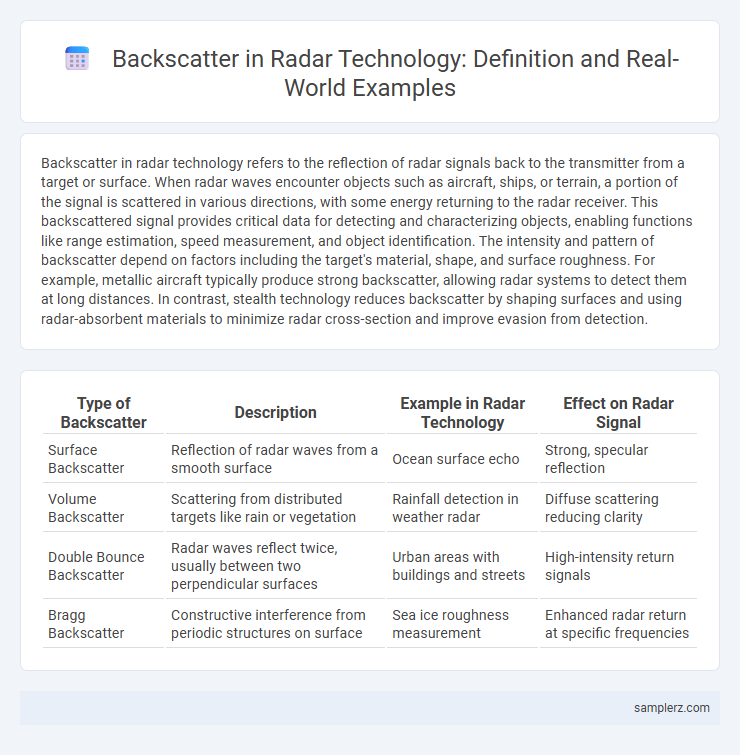Backscatter in radar technology refers to the reflection of radar signals back to the transmitter from a target or surface. When radar waves encounter objects such as aircraft, ships, or terrain, a portion of the signal is scattered in various directions, with some energy returning to the radar receiver. This backscattered signal provides critical data for detecting and characterizing objects, enabling functions like range estimation, speed measurement, and object identification. The intensity and pattern of backscatter depend on factors including the target's material, shape, and surface roughness. For example, metallic aircraft typically produce strong backscatter, allowing radar systems to detect them at long distances. In contrast, stealth technology reduces backscatter by shaping surfaces and using radar-absorbent materials to minimize radar cross-section and improve evasion from detection.
Table of Comparison
| Type of Backscatter | Description | Example in Radar Technology | Effect on Radar Signal |
|---|---|---|---|
| Surface Backscatter | Reflection of radar waves from a smooth surface | Ocean surface echo | Strong, specular reflection |
| Volume Backscatter | Scattering from distributed targets like rain or vegetation | Rainfall detection in weather radar | Diffuse scattering reducing clarity |
| Double Bounce Backscatter | Radar waves reflect twice, usually between two perpendicular surfaces | Urban areas with buildings and streets | High-intensity return signals |
| Bragg Backscatter | Constructive interference from periodic structures on surface | Sea ice roughness measurement | Enhanced radar return at specific frequencies |
Understanding Backscatter in Radar Technology
Backscatter in radar technology occurs when emitted radio waves hit an object and reflect back toward the radar system, enabling detection and imaging. This phenomenon is crucial in applications such as weather monitoring, where raindrops scatter radar signals, and in military surveillance for identifying aircraft or missiles. Understanding the intensity and pattern of backscatter helps optimize radar resolution and improve target classification accuracy.
How Backscatter Occurs in Radar Systems
Backscatter in radar systems occurs when transmitted radio waves encounter objects and reflect energy back to the radar antenna, creating detectable signals. The intensity of the backscatter depends on the object's size, shape, material, and surface roughness, affecting radar cross-section and signal strength. Understanding backscatter mechanisms enhances target detection accuracy and environmental monitoring through improved signal processing algorithms.
Common Examples of Backscatter in Radar Applications
Backscatter in radar technology is commonly observed in weather radar systems, where raindrops and snowflakes reflect transmitted signals back to the receiver, facilitating precipitation measurement. Another prevalent example is ground-penetrating radar, which detects subsurface objects by interpreting backscatter from soil layers and buried materials. Additionally, marine radar relies on backscatter from ocean waves and ship surfaces to identify vessel locations and navigate effectively.
Role of Backscatter in Weather Radar Detection
Backscatter in weather radar detection refers to the reflection of radar signals off precipitation particles such as raindrops, snowflakes, and hailstones, enabling the measurement of their size, intensity, and movement. This phenomenon allows meteorologists to accurately identify storm structures, rainfall rates, and potential severe weather events by analyzing the returned signal strength and patterns. Advanced weather radar systems utilize backscatter data to improve forecasting accuracy and real-time monitoring of atmospheric conditions.
Backscatter Phenomena in Aviation Radar
Backscatter phenomena in aviation radar occur when radar signals reflect off aircraft surfaces, atmospheric particles, or terrain features, causing scattered echoes that impact signal clarity. Specific materials like aluminum alloys used in aircraft fuselage significantly influence backscatter intensity, affecting radar detection range and accuracy. Understanding these reflections improves radar system calibration and enhances air traffic control safety by reducing false targets and improving object differentiation.
Backscatter from Natural Landscapes in Radar Imaging
Backscatter in radar imaging occurs when radar signals are reflected back to the sensor by natural landscapes, such as forests, mountains, and bodies of water. Vegetation typically causes volume scattering, producing complex backscatter patterns that vary with canopy density and moisture content. Mountainous terrains generate strong surface scattering due to rough surfaces, while calm water bodies often result in low backscatter due to smooth surface reflection.
Impact of Man-Made Structures on Radar Backscatter
Man-made structures such as buildings, towers, and bridges significantly influence radar backscatter by creating complex reflection patterns that vary based on material composition and geometry. These structures often produce strong, localized radar returns due to metallic surfaces and sharp edges, which enhance signal strength and affect radar image interpretation. Understanding the interaction between radar waves and urban environments is crucial for accurate target detection and clutter reduction in radar systems.
Backscatter Analysis for Target Identification in Radar
Backscatter analysis in radar technology involves examining the reflected radar signals that bounce back from objects to distinguish target characteristics such as shape, size, and material composition. By analyzing variations in the intensity and polarization of the backscattered signals, radar systems can accurately identify and classify targets even in cluttered environments. Advanced algorithms enhance this process by extracting unique backscatter signatures, improving object recognition and situational awareness in defense and remote sensing applications.
Case Studies: Backscatter in Maritime Radar Environments
Backscatter in maritime radar environments is critical for detecting small vessels and floating debris, as demonstrated in case studies of coastal surveillance systems where radar signals reflect off water surfaces and objects. Advanced algorithms analyze the backscatter patterns to differentiate between waves, ships, and marine wildlife, improving target classification accuracy by up to 30%. These case studies highlight the importance of backscatter analysis in enhancing situational awareness and navigational safety in congested sea routes.
Reducing False Alarms Caused by Backscatter in Radar
Reducing false alarms caused by backscatter in radar systems involves advanced signal processing techniques such as adaptive filtering and clutter suppression algorithms that differentiate between true target echoes and unwanted reflections. Implementing Doppler filtering effectively minimizes the impact of stationary or slow-moving objects that generate backscatter, improving detection accuracy in complex environments. Machine learning models trained on diverse radar return signatures further enhance false alarm reduction by classifying and filtering backscatter-induced noise from genuine target signals.

example of backscatter in radar Infographic
 samplerz.com
samplerz.com